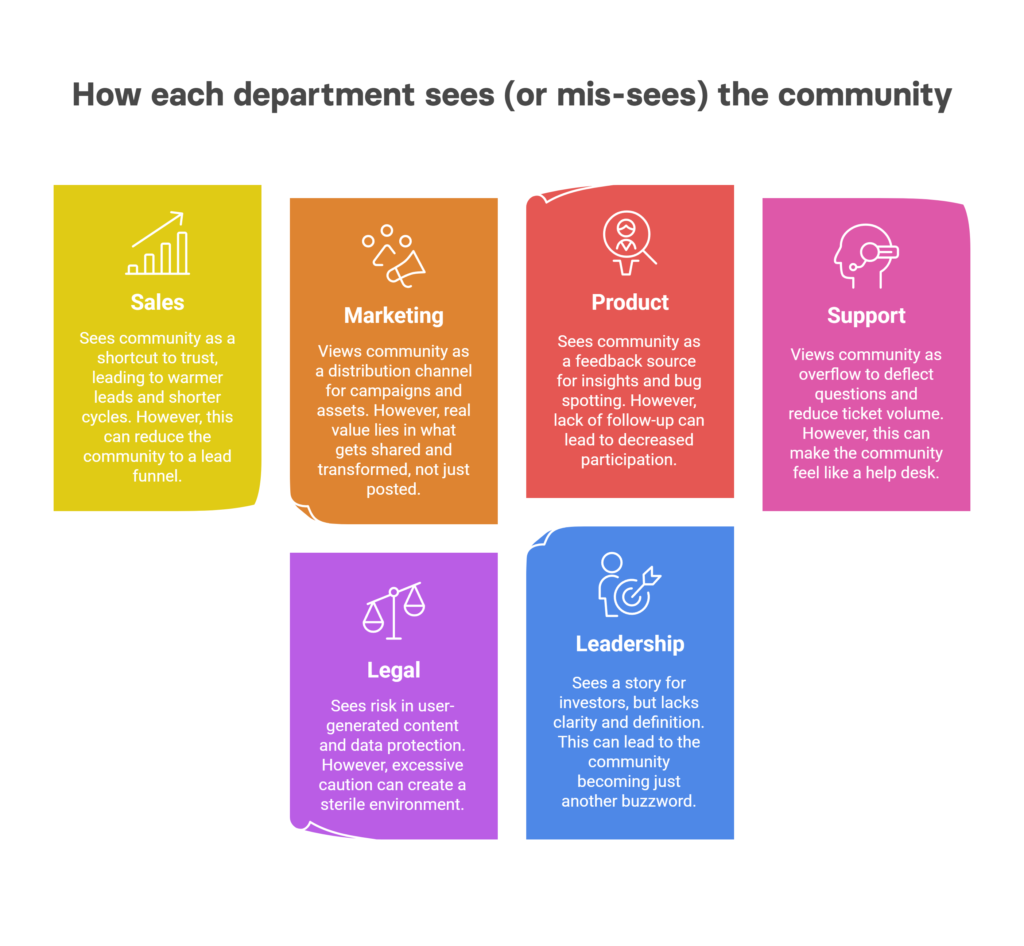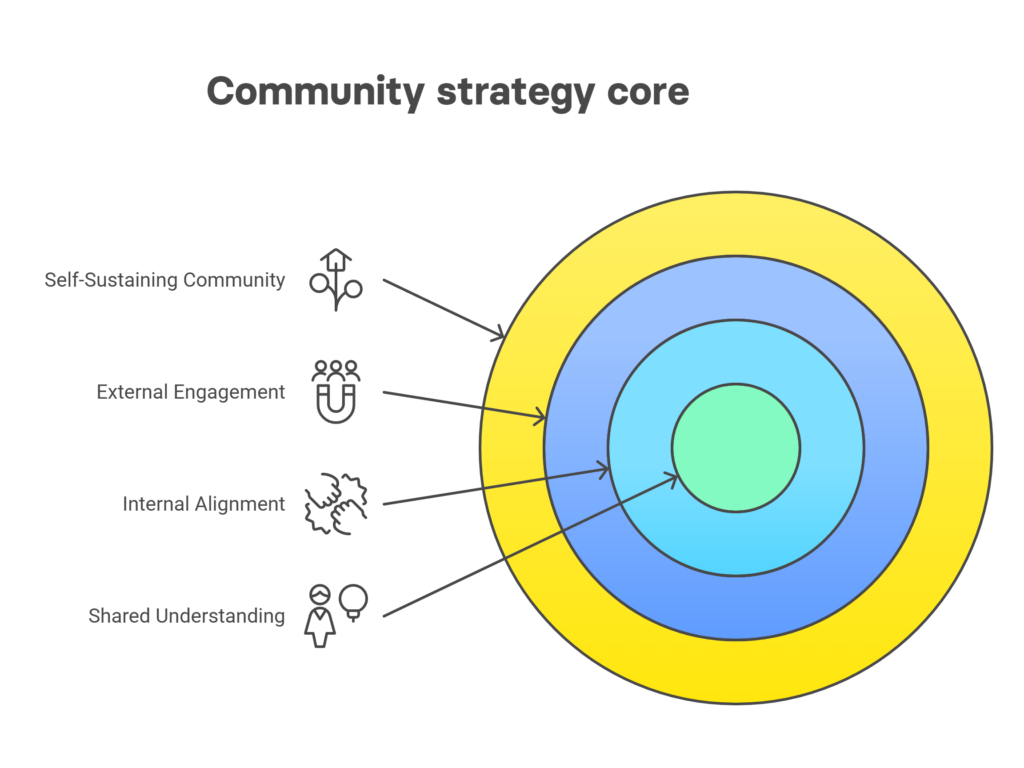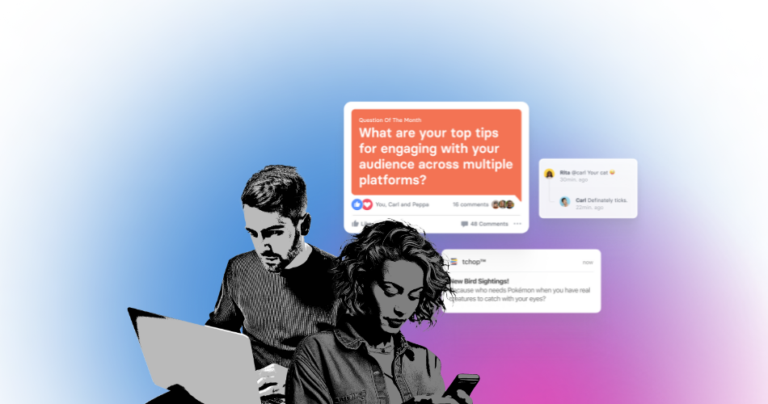Every company says they want a community. But ask five teams in the same organisation what that means, and you’ll get five completely different answers.
To sales, it’s a pipeline with a head start.
To marketing, it’s a new place to post things that didn’t work elsewhere.
To product, maybe it’s a free test group for half-built ideas.
Support sees it as a redirection path.
Finance sees a cost.
And the CEO? Says “community” because it plays well in a strategy deck.
Everyone sees potential. But almost no one is asking the harder question:
what is this actually for?
That’s how most community efforts begin. With energy, with intent, with vague alignment. Then things drift.
Maybe someone starts a forum, launches a Discord, spins up a newsletter or a branded app or a sleek new platform that promises better engagement, stronger feedback, richer data.
At first, there’s momentum, curiosity and a few wins. But then the questions start creeping in. Who owns it? Who’s keeping it alive? What are we measuring? Is this still a priority? And slowly, the community gets pushed further into the background. Still mentioned on slide 14 of the quarterly report but not really lived anymore.
That wouldn’t be a problem if community was just another tactic. But it isn’t.
The ones that work, the ones people return to, don’t feel like tactics at all. They feel like places. Real places with a culture, with an inside logic, with shared rituals and inside jokes and a tone you couldn’t replicate in a deck if you tried.
They’re not made by the brand. They’re shaped by the people who show up.
That kind of space doesn’t happen by accident. It takes clarity, consistency and a willingness to commit to something slower, messier and far more human than most teams are used to.
And that kind of clarity has to start on the inside because if the people building it aren’t aligned on what it is, what it’s for and who it’s really meant to serve; then what’s built will always reflect that confusion.
The result is familiar: a channel without gravity, a space that gets traffic but no participation and a community in name, but not in feel.
And that’s not just a missed opportunity. It’s a slow leak in trust, in energy and in the kind of loyalty that only forms when people feel like they’re part of something that knows exactly what it is.
How each department sees (or mis-sees) the community
The confusion doesn’t usually come from a lack of interest. Everyone wants the community to work. But each team sees it through their own lens and that lens shapes what they build, what they measure and what they quietly expect in return.
And when no one stops to align those expectations, the result is a kind of collective wishful thinking. Everyone’s contributing, but to different pictures in their heads.
Let’s look at a few of those pictures.

Sales sees community as a shortcut to trust
A place where people already know the brand, already see the value, already like the product enough to talk about it. Which means warmer leads, shorter cycles, more social proof. And on paper, that makes sense.
But when the space gets reduced to a lead funnel, something important starts to slip. The focus turns to conversion instead of connection, signals start getting interpreted as intent, people stop being people and start becoming segments and eventually, the room stops feeling like a room. It starts feeling like a waiting room with someone just around the corner, trying to pitch.
Marketing sees community as a distribution channel
Another place to put the campaign, post the asset, recycle the blog or the podcast or the reel that didn’t get the reach it deserved. The intent is usually good, “let’s bring value to the community.” But the execution often misses the mark.
Because the real value in a community isn’t what gets published. It’s what gets picked up, shared, talked about and transformed. If all you’re doing is posting at people, you’re building a bulletin board. And bulletin boards don’t talk back.
Product sees community as a feedback source
An easy way to gather insights, spot bugs, stress test new features and gauge sentiment. But more often than not, the loop never closes.
You ask for feedback. People give it. Then… silence. Nothing visible changes, no follow-up, no roadmap updates and no sense that the input mattered. And the next time you ask, fewer people answer. They still care but just stop believing.
Support sees community as overflow
A way to deflect basic questions, reduce ticket volume and create searchable answers. It works, up to a point. But if the only time someone enters the space is when they’re already frustrated, they won’t stay after the issue is fixed.
And the community ends up feeling like a help desk with poor lighting. No one sticks around to chat in a room that only lights up when something breaks.
Legal sees risk
User-generated content, moderation liability, data protection and a compliance checklist that’s rarely fun and often urgent. Their caution is valid but if it’s the only perspective guiding how the space is set up, you end up with a padded wall. Safe, but sterile. No edge, no energy and nothing worth remembering.
Leadership sees a story
A nice word for the investor memo, a slide in the pitch deck and a placeholder for future potential. Something they know should exist and they’d love to show off if only it had more numbers, more proof and more shape.
But clarity doesn’t trickle down from hope. It has to be built deliberately. Defined. Defended. Otherwise, it just becomes another buzzword with no home.
The cost of these silos

It’s not always obvious when the community starts to slip. There’s still activity, people still show up, something new gets posted every few days and nothing feels broken.
But look closer and the shape of the space starts to blur. No clear rhythm, no inside language and no sense of who the space belongs to, or what it stands for.
You might see a customer spotlight one day, a bug report the next and then a long stretch of silence followed by a promo code or a product update. It’s not that any of it is wrong. It’s that none of it is anchored.
And when the culture isn’t loud enough to carry a point of view, people stop knowing how to contribute or if they even should. So they lurk, drift and leave quietly. Not out of disinterest, just uncertainty.
It’s hard to stay part of something that never quite tells you what being “part of it” even means. And the more that happens, the more invisible the leak becomes. People don’t rage quit a community, they just stop checking. The tab stays open, until one day it doesn’t.
No alert, no warning. Just the slow erosion of something that once felt promising but never made it all the way to real.
And all of that, every bit of that is avoidable.
But not with a better content plan or a louder push notification strategy or a shiny new platform that promises better engagement.
It starts with the one thing most teams skip. Agreeing on what you’re actually building, together. Not in silos and not in theory. In practice, in language and in expectation.
Because if the teams building the space don’t share the same picture, the people entering it never will either.
What a real community strategy looks like
It’s not a roadmap. Not a calendar or a checklist or a six-part framework colour-coded by department.
It’s a shared understanding of who the community is for, why it matters and what kind of relationship you’re actually trying to build.
That doesn’t mean every team needs to agree on the same use case. But they do need to agree on the truth underneath the use case. The reason it exists at all. Not a pitch or an elevator line. Just a grounded answer to a very old question: who are we here for and what are we building with them?
If that answer changes every time you change rooms, something’s off.

The best communities don’t grow because someone posts more or moderates harder. They grow because people can feel what the space is trying to become and decide whether they want to be part of that.
Which means the first job of any community strategy isn’t scale but alignment. Internal, then external.
- Can everyone on the team explain what the community is without naming a platform?
- Can they tell you what a “healthy” week in the space looks like?
- Can they name the culture, not just the content?
Because that’s what shapes how people show up. That’s what lets someone enter and know instantly if this is a room where they belong or one they’re just visiting.
And once that kind of shape takes hold, it starts to protect itself. You don’t need to beg for replies or force engagement or gamify the silence. The space carries its own weight. Not because it’s busy but because it means something.
You can’t fake that. You can build toward it.
But only if you’re clear on what you’re aiming for and honest about who needs to be in the room to shape it. Not just the community team, not just marketing but everyone.
Because community doesn’t live in a single department. It shows up everywhere or it doesn’t show up at all.
What it really takes to build a community that lasts
Most teams don’t mean to get community wrong.
They’re busy, stretched and are trying to deliver numbers that make sense in dashboards and updates that sound good in meetings. And “community” is one of those words that seems like it should fit everywhere, until you actually try to build one.
Because what you’re really building isn’t a channel or a feature. It’s a culture. Something alive, with its own memory, momentum and meaning. Something that asks a little more than usual and gives a lot more back, if you let it.
But it only works when it’s built together.
- When product doesn’t just listen to feedback but loops people in early.
- When marketing doesn’t just push messages but learns the language of the room.
- When leadership doesn’t just sponsor the idea but shows up to live it.
- When everyone understands that the real win isn’t reach or clicks or even retention, it’s belonging.
That’s what makes a community different from every other part of the business. It doesn’t just reflect what you do, it reveals who you are, how you show up, how you listen and what you value when no one’s asking. And in a world where platforms change and strategies evolve, that’s the only thing that really sticks.
So if you’re building a community, start there. Not with the tech or with the posts but with the people.
The ones inside the company, the ones already in the room, the ones who’ve been waiting for a space that feels like it was made for them, not just managed around them.
That kind of space doesn’t need a launch plan. It needs a commitment to alignment, listening, something slower, deeper and more human than most teams are used to.
And if you can build that, then what you’ve got isn’t just a community, it’s a future that people actually want to be part of.







